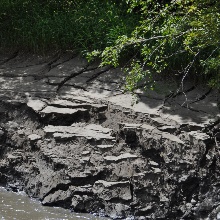Important Results
1) The erosion stability of the sediment deposits were largest in the reservoir Großer Brombachsee compared with those of other reservoirs (depth-averaged mean critical shear stress of 4.69 Pa), followed by the reservoirs Kleiner Brombachsee (0.51 Pa) and the Schwarzenbachtalsperre (0.38 Pa).
2) The critical shear stress correlates positively with the bulk density and clay content (for the Großer Brombachsee) and the sand content (for the Schwarzenbachtalsperre) and negatively with the measured organic matter for both reservoirs.
3) The 3D numerical simulations for reservoir management (sediment transport and reservoir flushing) of the Schwarzenbach reservoir showed a clear dependence on inflow, water level in the reservoir, and sediment properties. The most efficient form of reservoir flushing was achieved at full drawdown (achieves a sediment equilibrium).
Brief summary
Motivation: Knowledge acquisition on the incipient of motion and the transport behavior of fine sediments (cohesive sediments)
Novelty: Depth-depending investigation of complex physico-chemical interactions and biological activity in the sediment layers
Strategy: In-situ measurements, laboratory investigations, numerical modeling
Methods: SETEG flume (initiation of motion, τcrit), EROMOB (initiation of motion in-situ, τcrit), LISST (SSC, PSD, sedimentation velocity), ADCP (flow measurements), SSIIM 2 (numerical model)
Expected results: Key-parameter determination responsible for resuspension and transport behaviour, numerical model implementation
Reservoirs are complex systems that have been constructed by mankind since ancient times (known from 5000 BC) to store water for a multitude of purposes. The focus is world-wide on ensuring drinking and irrigation water, which is of obvious significance for countries suffering from physical water scarcity due to shortages, depletion and/or anthropogenic deterioration of water resources.
(A) Motivation: Siltation effects are a serious problem in many reservoirs, resulting in an ongoing loss of storage volume. Especially fine sediment depositions are a major problem for the reservoir management. The success of management strategies (e.g. flushing) with respect to siltation effects is difficult to predict, because of complex physico- chemical interactions and biological activity in the sediment layers and the sediment particles itself where cohesion and adhesion properties vary in spatial and temporal terms.
(B) Aims: The objective of WP1 is to identify key parameters which govern resuspension processes and sediment transport mechanisms, leading to an improved understanding of the behaviour of fine sediments in reservoirs. There is still no general analytical theory for cohesive sediment resuspension available because of a lack of multidisciplinary basic research to warrant a better and more realistic understanding of cohesive sediments in natural systems. Therefore, it is essential to learn more about specific sediment properties influencing the incipient of motion and the transport behaviour of fine sediments.
(C) Methods: Sediment cores will be collected and analysed in detail in the SETEG flume (Stroemungskanal zur Ermittlung der tiefenabhängigen Erosionsstabilitaet von Gewaessersedimenten) in the hydraulic laboratory. Herewith, the unique depth-dependent evaluation of sediment stability in combination with a determination of bulk density (by gamma-ray attenuation) allows for deeper insights into the structure of the depositions and results in specific high resolution data of depth-dependent critical bed shear stresses (τcrit). Furthermore, water content, bulk density, particle composition (clay, silt and sand), total organic carbon (TOC) and the cation exchange capacity (CEC) will be determined in distinct layers. In order to complement the laboratory results by field data, a benthic flume (EROMOB) will be applied to quantify the erosion stability in the upper deposition layers in situ.
(D) Achievable Goals: The findings from the laboratory (SETEG) and the in-situ measurements (EROMOB) will be correlated to describe relationships between the measured critical shear stress of the sediment depositions and the multitude of heterogeneous and complex parameters to unravel the interactions between them. An additional focus is on biological influences and methane release from sediments. In a further step these new findings and relations between the evaluated values and the obtained critical shear stress will be used to elaborate new approaches which will be considered in conceptually refined models of the relevant physical processes. These new approaches will be used to develop algorithms that will be implemented into the numerical model SSIIM.
Implementing the cohesive and adhesive nature of fine sediments in the appropriate model approaches will result in a better description and an improved simulation of sediment dynamics. This will finally lead to more effective reservoir sediment management strategies.



